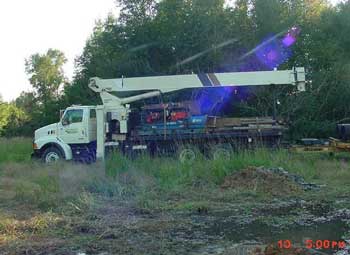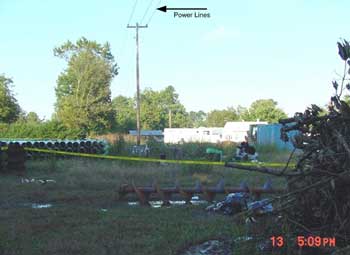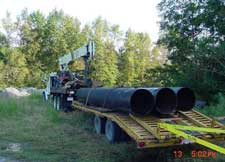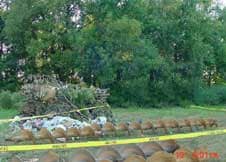Hispanic Laborer Electrocuted When Crane Boom or Load Line Contacts 7,200 Volt Overhead Power Line - North Carolina
NIOSH In-house FACE Report 2005-01
July 7, 2005
Summary
On October 12, 2004, a 26-year-old Hispanic laborer (the victim) was electrocuted at a materials storage yard, as he guided an auger being lifted by a truck-mounted crane onto a truck. A 7,200 volt overhead power line ran through the middle of the 5-acre materials storage yard. The victim was holding on to the auger when the truck boom moved, apparently causing the crane boom or load line to contact the power line, and the electricity to flow through the victim’s body. Two workers employed by another subcontractor that were assisting the victim were also shocked and knocked to the ground by the electric current. They were not permanently injured. The crane operator saw that the three employees had fallen to the ground. He came down from the crane operating position and ran to check on the men and look at the crane boom, the load line, and the power lines. [Since the crane operator was not shocked, it is assumed that he moved the boom away from the power lines before exiting the crane cab.] He then ran back to the operating position, lowered the auger to the ground, and then returned to the men. Finding that the victim had no apparent pulse and did not appear to be breathing, the crane operator began cardiopulmonary (CPR) resuscitation efforts. One of the workers who had been shocked ran to a nearby building to call 911, while the other waited for Emergency Medical Services (EMS). EMS personnel responded within approximately 20 minutes and continued CPR on the victim. The victim remained unresponsive and was transported by ambulance to a nearby hospital, where he was pronounced dead by an emergency room physician. The two injured workers were transported to another hospital in the area and examined. One of them was released that day, and the other was admitted to the hospital and released two days later.

|
|
Photo 1. This photograph illustrates the truck-mounted crane that was used on the day of the incident. [Photograph courtesy of NCOSH].
|
NIOSH investigators concluded that, to help prevent similar occurrences, employers should:
- assign a competent persona to conduct a jobsite survey during the planning phases of any construction project to identify potential hazards, and to develop and implement appropriate control measures for these hazards.
- train all crane operators and crews who may work near overhead power lines to maintain minimum clearance from overhead power lines at all times.
- develop, implement and enforce a comprehensive safety program, and provide safety training in language(s) and literacy level(s) of workers, which includes training in hazard recognition and the avoidance of unsafe conditions.
Additionally,
- municipalities should consider requiring in their bid specifications that all contract proposals include a written comprehensive safety program that addresses safe operating procedures and documents worker training for all tasks to be performed under the contract.
- The authority having jurisdiction for providing emergency medical services should identify and address barriers to timely response to medical emergencies.
a Competent person — one who is capable of identifying existing and predictable hazards in the surroundings or working conditions which are unsanitary, hazardous, or dangerous to employees, and who has the authority to take prompt corrective measures to eliminate them.1
Introduction
On October 12, 2004, a 26-year-old Hispanic laborer (the victim) was electrocuted at a materials storage yard, as he guided an auger being lifted by a crane onto a truck. Two other employees of another subcontractor that were assisting the victim were also shocked and knocked to the ground, but were not permanently injured. On November 3, 2004, the North Carolina Occupational Safety and Health (NCOSH) office notified the National Institute for Occupational Safety and Health (NIOSH), Division of Safety Research (DSR), of the incident. On November 15, a DSR safety and occupational health specialist met with the NCOSH compliance officer assigned to the incident. The DSR safety and occupational health specialist accompanied the NCOSH compliance officer to the incident site the following day, took photographs, and interviewed a city engineer/volunteer firefighter who had responded to the incident. The victim’s employer declined an interview. The police report and medical examiner’s report were reviewed. The cause of death was obtained from the medical examiner.
Employer: The victim’s employer, a jack and boring subcontractor, had five employees and had been in business for seven years. The employer frequently worked with another subcontractor on water utility jobs. The municipality had contracted with both the victim’s employer and the jack and boring contractor with whom the employer frequently worked, to complete jack and boring operations. The employer had no written safety and health program or documented training for any of his employees, including the victim.
Victim: The victim was Hispanic and had traveled from Mexico to the U.S. to work as a laborer. He had a social security number and a resident alien card. He spoke primarily Spanish. Because the victim’s employer declined an interview with the DSR investigator, the victim’s length of time in the United States, his length of employment with his employer, and previous employment experience were not obtained.
Equipment: The truck-mounted crane used at the time of the incident was an articulating telescopic boom crane (Photo 1). The truck crane was operated by the employer’s foreman, but was owned by the other jack and boring subcontractor that had been contracted for the project. The foreman (crane operator) had worked for the employer for 7 years. His training was not documented.
Incident site: A 5-acre, flat, vacant lot owned by the city was provided as a materials storage yard to the contractor and subcontractors working on the water utility project. There was a 7,200 volt power line running through the middle of the materials storage yard approximately 27 feet above ground level. The yard was used to store materials and equipment for the water utility project such as augers, carrier pipes, and steel pipes. This was the employer’s first fatality.
Back to Top
Investigation
A municipality had contracted with a general contractor to complete a 3-million dollar municipal wastewater improvement project. The victim was employed by one of two companies, working together, that were subcontracted to perform jack and boring operations. On the day of the incident, several laborers, including the victim, worked all day with an equipment operator who ran a horizontal boring machine to jack and bore under sections of a state highway to place underground water pipes, according to contract specifications. Horizontal boring was done because North Carolina statutes do not allow cutting into state roads. In all other areas, the ground was excavated and the water utility lines were laid by other subcontractors in the open trenches using backhoes.
At approximately 2:00 p.m., the jack and boring crew finished jack and boring operations under a section of state highway and returned to the materials storage yard (Photo 2) to load pipe and augers for the following day’s work. The crew manually loaded three 20-foot sections of steel pipe onto a truck trailer (Photo 3). Because the 20-foot augers (Photo 4) were too heavy to manually move, the company’s crane operator or a crew member had hooked a crane cable line to one of several augers lying on the ground and the crane operator had started extending and raising the boom to make it easier for laborers to slide the auger into the steel pipe already on the truck trailer.
The victim was holding on to the auger when the truck-mounted crane boom apparently moved, causing the crane boom or load line to contact the overhead power line, and the electricity to flow through the victim’s body. Two workers employed by another subcontractor that were assisting the victim were also shocked and knocked to the ground by electricity. They were not permanently injured. The crane operator saw that the three employees had fallen to the ground. He came down from the crane operating position and ran to check on the men and look at the crane boom, the load line, and the power lines. [Since the crane operator was not shocked, it is assumed that he moved the boom away from the power lines before exiting the crane cab.] He then ran back to the operating position, lowered the auger to the ground, and then returned to the men. Finding that the victim had no apparent pulse and did not appear to be breathing, the crane operator began cardiopulmonary (CPR) resuscitation efforts. One of the workers who had been shocked ran to a nearby building to call 911, while the other waited for Emergency Medical Services (EMS). EMS personnel responded within approximately 20 minutes and continued CPR on the victim. The victim remained unresponsive and was transported by ambulance to a nearby hospital, where he was pronounced dead by an emergency room physician. The two injured workers were transported to another hospital in the area and examined. One of them was released that day, and the other was admitted to the hospital and released two days later.
The city engineer responded to the incident before the EMS arrived and observed the location of the crane boom, cable line, and power lines. At the time of his arrival, the crane boom was 4-5 feet above the closest power line phase. There was approximately 3-4 feet horizontal separation between the crane cable and the closest power line conductor. The city engineer contacted the power company and the power lines were de-energized and not returned to operation until the victim, injured workers, and emergency responders were out of the area. While the power lines were de-energized, the augers and pipes were moved to another location and the city engineer measured the distance from the earth to the power lines above. The conductors were located approximately 27 feet above ground level. The city engineer reported that contractors had been warned verbally about the power lines overhead, but since the area was so large and there were areas for storage away from the power lines, the location was suitable for equipment and materials storage. The DSR safety and occupational health specialist noted that the storage yard was quite large and there were large, unused spaces well away from the power lines. Also, there was standing water noted on the ground under the power lines.

|
|
 |
 |
| Photo 3. This photo illustrates the sections of pipe on the truck trailer into which the steel augers were to be inserted. [Photograph courtesy of NCOSH]. | Photo 4. This photo illustrates the steel augers that were being lifted with the truck crane and inserted into sections of steel pipe located on the truck trailer. [Photograph courtesy of NCOSH]. |
Back to Top
Cause of Death
The medical examiner’s office reported that the cause of death was electrocution.
Recommendations/Discussion
Recommendation #1: Employers should conduct a jobsite survey during the planning phases of any construction project to identify potential hazards, and to develop and implement appropriate control measures for these hazards.
Discussion: Before beginning work at any construction site, a competent person should evaluate the site to identify any potential hazards and ensure appropriate control measures are implemented. At the materials storage yard, a 3-phase 7,200 volt overhead power line was located directly above the area where steel augers and steel pipe had been stored. Materials and equipment should be stored a safe distance away from all power lines, if possible.
In situations where there is a potential electrical hazard but work cannot be relocated, employers should work with the utility company to minimize or eliminate the hazard.2, 3
All workers on site should be made aware of hazards present and the control measures that are to be followed to avoid them.
Recommendation #2: Employers should train all crane operators and crews who may work near overhead power lines to maintain minimum clearance from overhead power lines at all times.
Discussion: Occupational Safety and Health Administration (OSHA) standards for the Construction Industry have specific requirements for using cranes and derricks located in Subpart N.4 29 CFR 1926.550(a)(15) requires that “except where electrical distribution and transmission lines have been de energized and visibly grounded at point of work or where insulating barriers, not a part of or an attachment to the equipment or machinery, have been erected to prevent physical contact with the lines, equipment or machines shall be operated proximate to power lines only in accordance with the following: (i) for lines rated 50 kV. or below, minimum clearance between the lines and any part of the crane or load shall be 10 feet.”
Also under general requirements for cranes and derricks located in 29 CFR 1926.550(a)(15)(iv), OSHA requires that “A person shall be designated to observe clearance of the equipment and give timely warning for all operations where it is difficult for the operator to maintain the desired clearance by visual means.” OSHA standard 29 CFR 1926.550(a)(4) requires that “Hand signals to crane and derrick operators shall be those prescribed by the applicable [not part of quote: added by author: American National Standards Institute] (ANSI) standard for the type of crane in use. An illustration of the signals shall be posted at the job site.” Hand signals in accordance with ANSI B30.55 were prescribed for the type of crane in use, but no worker had been designated to guide the crane operator and the hand signals were not posted at the site on the day of the incident. All employers should comply with and reinforce these safety requirements through safety training and during safety meetings. Training should always include procedures that crane operators are to follow in the event of contact between a crane and an energized line. The Construction Safety Association of Ontario, Canada (CSA) recommends that the following safety procedures be followed:
- The crane operator should remain inside the cab.
- All other personnel should keep away from the crane, ropes, and load, since the ground around the machine might be energized.
- The crane operator should try to remove the crane from contact by moving it in the reverse direction from that which caused contact.
- If the crane cannot be moved away from contact, the operator should remain inside the cab until the lines have been de-energized.6
In this instance, since the crane operator was not shocked, he most likely reversed the boom sufficiently to move it away from contact with the lines, got off the crane to evaluate the situation, and then reentered the crane cab to lower the load to the ground.
Information useful for training workers about hazards involved with crane operations near overhead power lines can be found in the NIOSH Alert: Preventing electrocutions of crane operators and crew members working near overhead power lines.2 In addition, Worker Deaths by Electrocution, A Summary of NIOSH Surveillance and Investigative Findings3 provides additional information for worker training. Both documents are available through the NIOSH web site at https://www.cdc.gov/niosh/topics/electrical/ or by calling 1-800-356-4674. The NIOSH Alert has a worker/employer summary sheet that can be posted at the work site or given to workers and may serve as an additional means to communicate safe work practices to workers. (Link updated 3/21/2013)
If employers have implemented additional controls for the crane, such as installing proximity warning alarms and or insulated links, training should emphasize that these are supplemental and are not a substitute for maintaining minimum clearances.
Current federal laws do not require crane operators to be licensed or certified. At present, 12 states (California, Connecticut, Hawaii, Massachusetts, Montana, Nevada, New Jersey, New Mexico, New York, Oregon, Rhode Island, West Virginia) and 6 cities (Chicago, Los Angeles, New York, New Orleans, Omaha, Washington DC) require crane operators to be licensed. Certification is usually a voluntary process initiated by a non-governmental agency through which individuals are recognized for their knowledge and skill.7 Licensure is more restrictive and usually refers to mandatory governmental requirements based upon some combination of examination, testing, and demonstration of the appropriate skills, knowledge and experience. A negotiated rulemaking committee for OSHA has drafted revised regulations for crane and derrick safety that would require crane operator testing and certification.8 To exercise good safety practice, employers should consider implementing an operator testing and certification program regardless of this proposed rule change.
Recommendation #3: Employers should develop, implement and enforce a comprehensive safety program, and provide safety training in language(s) and literacy level(s) of workers, which includes training in hazard recognition and the avoidance of unsafe conditions.
Discussion: Employers should evaluate tasks performed by workers, identify all potential hazards, and then develop, implement, and enforce a safety program that meets applicable OSHA standards addressing these identified hazards. The safety program should include, at a minimum, worker training in hazard identification, and the avoidance and abatement of these hazards.9
Companies that employ workers who do not understand English should identify the languages spoken by their employees and design, implement, and enforce a multi-language safety program. To the extent feasible, the safety program should be developed at a literacy level that corresponds with the literacy level of the company’s workforce. Companies may need to consider providing special safety training for workers with low literacy to meet their safety responsibilities. The program, in addition to being multi-language, should include a competent interpreter to explain worker rights to protection in the workplace, safe work practices workers are expected to adhere to, specific safety protection for all tasks performed, ways to identify and avoid hazards, and who they should contact when safety and health issues arise.
Recently OSHA developed The Hispanic Outreach Module to assist employers with a Spanish-speaking workforce in learning more about workplace rights and responsibilities, identifying Spanish-language outreach and training resources, and learning how to work cooperatively with OSHA. In addition, the module provides a list of OSHA’s Hispanic/English-as-a-second- language coordinators. These materials are available at https://www.osha.gov/dcsp/compliance_assistance/index_hispanic.htmlexternal icon 10 or can be obtained by contacting an OSHA area office. Information provided can be used by employers who are developing or improving safety and training programs for their Spanish speaking employees.
Recommendation #4: Municipalities should consider requiring in their bid specifications that all contract proposals include a written comprehensive safety program that addresses safe operating procedures and documents worker training for all tasks to be performed under the contract.
Discussion: To help foster safe work environments for contracted employees, municipalities can require all potential contractors to submit a written safety program as part of their bid specifications. By requiring in the bidding process that safety programs, at minimum, meet OSHA safety and health standards, contractors are reminded of the importance of safety and that the costs of safety are a recognized and necessary cost of doing business.
Recommendation #5: The authority having jurisdiction for providing emergency medical services should identify and address barriers to timely response to medical emergencies.
Discussion: According to the city engineer, who was also a volunteer firefighter, the EMS ambulance arrived at the incident site approximately 20 minutes after the 911 call. The ambulance traveled from a nearby town to the site but was unable to locate the vacant lot immediately. Ambulance drivers should maintain contact with dispatchers and request a clarification of the incident location when needed. Agencies responsible for providing EMS ambulance services might consider installing global positioning systems and/or computers equipped with mapping software in EMS ambulances to assist drivers in locating sites. The National Fire Protection Association (NFPA) has developed consensus standards regarding response times for career 11 and volunteer fire departments.12 Two of the objectives for career fire departments identified in NFPA 1710 refer to emergency medical response time and include: Four minutes (240 seconds) or less for the arrival of a unit with first responder or higher level capability at an emergency medical incident, and eight minutes (480 seconds) or less for the arrival of an advanced life support unit at an emergency medical incident, where this service is provided by the fire department. For volunteer fire departments, NFPA 1720 recommends that emergency medical service response times in rural areas be within 14 minutes 80 percent of the time. The incident summarized in this report occurred in a rural area.
The authority having jurisdiction and responsibility for providing emergency medical services, regardless of its designation as a career fire department, volunteer fire department, or private EMS, should identify and address barriers to timely response to medical emergencies and strive to meet the NFPA consensus standards for response times.
Back to Top
References
- Code of Federal Regulations [2004]. 29 CFR 1926.32(f). General Safety and Health Provisions. Washington, DC: U.S. Printing Office, Office of the Federal Register.
- NIOSH [1995]. NIOSH Alert: Request for Assistance in Preventing Electrocutions of Crane Operators and Crew Members Working Near Overhead Power Lines. Cincinnati, OH: U.S. Department of Health and Human Services, Public Health Service, Centers for Disease Control and Prevention, National Institute for Occupational Safety and Health, DHHS (NIOSH) Publication No. 95-108.
- NIOSH [1998]. Worker Deaths by Electrocution: A Summary of NIOSH Surveillance and Investigative Findings. Cincinnati, OH: U.S. Department of Health and Human Services, Public Health Service, Centers for Disease Control and Prevention, National Institute for Occupational Safety and Health, DHHS (NIOSH) Publication No. 98-131.
- Code of Federal Regulations [2004]. 29 CFR 1926.550. Cranes and Derricks. Washington, DC: U.S. Printing Office, Office of the Federal Register.
- ANSI [1968]. American National Standard: Hand Signals. New York, NY: American National Standards Institute, Inc. ANSI B30.5-1968.
- CSA (Construction Safety Association) [1982]. Mobile crane manual. Toronto, Ontario, Canada: Construction Safety Association of Ontario.
- NCCCO [2004]. National Commission for the Certification of Crane Operators: State Licensing Requirements. Fairfax, VA. http://www.nccco.org/nccco/certification-programs/certification-overviewexternal icon. Accessed April 5, 2005. (Link updated 8/13/2013)
- DOL (U.S. Department of Labor)[2004]. Consensus reached on recommendation for OSHA cranes and derricks standard. Press release, 13 July 2004. Washington, DC. [https://www.osha.gov/pls/oshaweb/owadisp.show_document?p_table=NEWS_
RELEASES&p_id=10938external icon]
- Code of Federal Regulations [2004]. 29 CFR 1926.21(b)(2). Safety Training and Education. Washington, DC: U.S. Printing Office, Office of the Federal Register.
- OSHA [2005]. Hispanic Outreach Module. Accessed February 3, 2005 at https://www.osha.gov/dcsp/compliance_assistance/index_hispanic.htmlexternal icon
- NFPA [2004]. NFPA 1710: Standard for the organization and deployment of fire suppression operations, emergency medical operations, and special operations to the public by career fire departments. Quincy, MA: National Fire Protection Association.
- NFPA [2004]. NFPA 1720: Standard for the organization and deployment of fire suppression operations, emergency medical operations, and special operations to the public by volunteer career fire departments. Quincy, MA: National Fire Protection Association.
Back to Top
Investigator Information
This investigation was conducted by Doloris N. Higgins, Safety and Occupational Health Specialist, Fatality Investigations Team, Surveillance and Field Investigations Branch, Division of Safety Research, National Institute for Occupational Safety and Health.
In-house Reports
